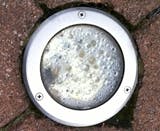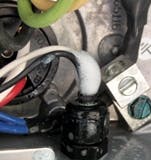This article was published in the March 2013 issue of LEDs Magazine.
View the Table of Contents and download the PDF file of the complete March 2013 issue, or view the E-zine version in your browser.
+++++
Much of the lighting for both commercial and residential applications is being upgraded to LED sources because solid-state lighting (SSL) products can deliver 100,000 hours of light and are some of the most environmentally friendly and reliable solutions — especially in outdoor lighting applications. However, outdoor applications can present a challenging environment with potential water ingress that can cause product failures. Although product developers can seal a luminaire against the environment, the unexpected problem of pressure differential between the inside of the luminaire and the outside air can cause problems. Let’s examine the pressure issue and consider mechanical design approaches to eliminate the problem and ensure long luminaire lifetime.
The advantages of LED luminaires are numerous. In addition to the previously noted long-life potential, SSL products are fully compliant with the restriction of hazardous substances (RoHS) regulations and provide up to 85% energy savings over legacy lighting technologies.
Although the LEDs themselves can last for more than 20 years, this service life only provides added value to the lighting system if the electronic components and power supply and drivers are as reliable as the LEDs. All of the components in the luminaire must be able to withstand the harsh conditions of the environments in which they are installed, whether in the tropical climates of the Caribbean or the extreme cold of Alaska.
Most engineers protect the drivers and electronics by enhancing the durability of the luminaire housing in one of three ways: integrating more rugged O-rings or gaskets to improve the seals, increasing the thickness of the enclosure’s walls to minimize movement of the housing around the seal, and/or installing additional bolts around the O-rings or gaskets to maintain a more durable seal. However, even with these added features, the seals can begin to fail and become a leak point, providing a path for water to enter and eventually cause condensation on the lens and reflectors.
These failures often occur because sealing the device prevents its ability to handle pressure fluctuations, both positive and negative (i.e., vacuum). As these pressure fluctuations occur, they put significant stress on seals and other connection points, which in turn compromises their effectiveness. Over time, the frequent expanding and contracting of the seals causes their weakest point to fail, allowing water and contaminants to enter the housing and leading to potential corrosion, shorts and failure of the electronics.
As the temperature rises, the air inside the luminaire expands, putting positive pressure on the seals, joints, and connection points. As the temperature drops, the internal air compresses and creates a vacuum, again putting pressure on the seals. A 30°C change in temperature would create approximately 10% of volumetric airflow in or out of the luminaire.
A quick drop in the outside temperature can create a vacuum of 0.5 psi or greater inside the enclosure. When a vacuum occurs, water and contaminants can enter the housing. In mild cases, corrosion is accelerated, and in severe cases, catastrophic failure could occur. The corrosion can shorten the life of the luminaire by damaging wiring, leads, and other electronics contained within the luminaire and the LEDs.Fig. 1 shows how temperature can fluctuate inside and outside the luminaire mapped relative to power on and off cycles for the luminaire. Temperature rises inside the luminaire when it is powered on. As a luminaire turns on and off, the changes in the temperatures result in sudden pressure differentials (Fig. 2). The housing tries to relieve the pressure by drawing air inside, which increases stress on the seals (a process sometimes referred to as pressure equalization).
Altitude changes are another common cause of pressure buildup. Although luminaires are usually stationary once installed, altitude issues occur as the luminaires are shipped from the manufacturing facility to the installation site. Because most shipping containers on cargo planes are not pressurized, luminaires can be exposed to significant pressure differentials during take-off and landing, decreasing from almost 15 psi (1034 mbar) when on the ground to about 3 psi (137.9 mbar) at an altitude of 40,000 feet (Fig. 3).
Thermal shock is a third cause of pressure differentials and results from the luminaire being exposed to rain, snow, or washing cycles. Fig. 4 shows the impact on a luminaire’s internal pressure from a water spray using an IEC 60529 Standard IPX5 nozzle at a distance of approximately 3m for three minutes, with a tap water flow of 21 lt/min. Rapid recovery of pressure indicates the failure of the gasket to hold the vacuum, drawing in water along with air at the leak path(s).Condensation: Another consequence
In addition to the potential damage to electronics if water and contaminants enter the luminaire, moisture vapor from the water can cause condensation on lenses and reflectors, decreasing light efficiency and the aesthetic quality of the luminaire (Fig. 5).
The relative humidity inside the luminaire determines the potential for condensation occurring on the lenses and reflectors. When the relative humidity inside the luminaire reaches 100%, condensation occurs. Once this happens, the condensation will remain unless there is a path for the moisture vapor to escape. Because sealed enclosures do not provide this path, condensation will remain on the lenses and reflectors for extended periods (Fig. 6).
Many engineers consider hermetic seals or potting compound to be the best way to protect electronics. However, hermetically sealing the device requires the use of non-permeable materials — which means no plastic — and the housing is welded shut. This option is unrealistic for most luminaires because the enclosures would be too heavy, not serviceable, and very expensive. Like hermetic seals, potting compound eliminates the ability to service the electronics, is expensive and heavy, and requires specialized equipment in the manufacturing process.
Installing a felt element, sintered vent, or mechanical valve is another alternative. The felt element and sintered vent address the pressure differentials, but like tortuous paths, they allow water and contaminants to enter and clog the air path. And the mechanical valve is a one-way solution, allowing air to escape only if internal pressure increases to a certain point, but remaining closed if a vacuum occurs.A vent made of expanded polytetrafluoroethylene (ePTFE) – a two-way breathable membrane – continuously equalizes pressure inside the luminaire housing while maintaining an environmental seal. Expanded PTFE is a unique, microporous membrane that is inherently waterproof and chemically inert, and can be coated to provide oleophobicity, essentially protection from oil. The ePTFE node-and-fibril microstructure is open enough to allow gas molecules and vapor to pass through it easily, but the openings are so small that liquid and other particulates are repelled.
Depending on the quality of the seal, negative 34 mbar (approximately 0.5 psi) is commonly accepted as the point at which a vacuum can cause a leak in a sealed enclosure. Although the on/off cycle of a luminaire causes temperatures to rise and fall in both a vented and a sealed enclosure, the amount of pressure placed on the seals and joints is significantly different (Fig. 8). The testing indicated that pressure in the sealed luminaire spiked as much as 0.09 psi when the light was turned on and dipped approximately -0.1 psi when turned off. However, the vented luminaire showed a change of only ±0.01 psi.
Over the course of 10 days, the relative humidity of the sealed luminaire almost always remained at 100%, which indicated the existence of condensation inside the luminaire caused by water entering during the test. Although the relative humidity in the vented luminaire rose after the shock test, it decreased as the moisture vapor escaped from the enclosure, and there was no evidence of condensation.
As demonstrated through the real-life IPX5 testing done by Gore, integrating an ePTFE vent into the luminaire’s housing equalizes pressure by allowing continuous airflow in both directions. This two-way airflow prevented water from entering as the pressure changes inside or outside the enclosure. Also, the vent reduced condensation events inside the luminaire because moisture vapor was able to escape before condensing.
For more information about the testing Gore performed, visit gore.com/protectivevents, or email [email protected] and request the white paper, “Reliability testing of Gore protective vents in LED luminaires.”














